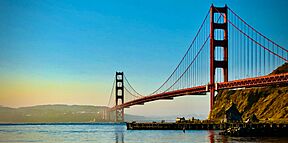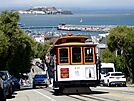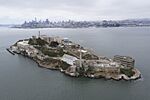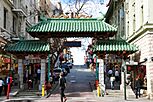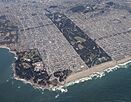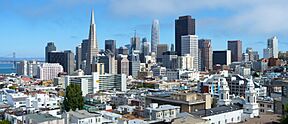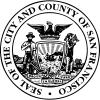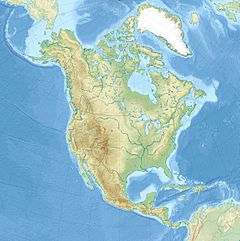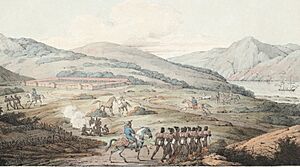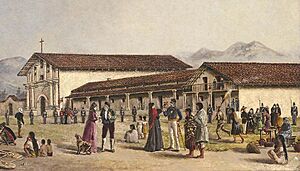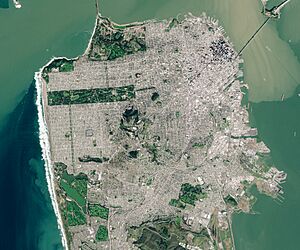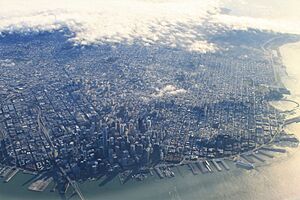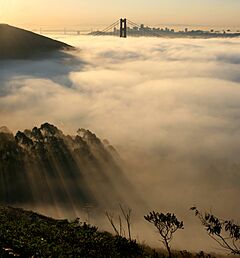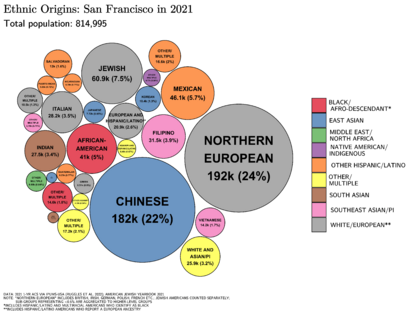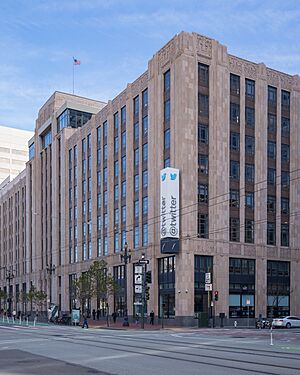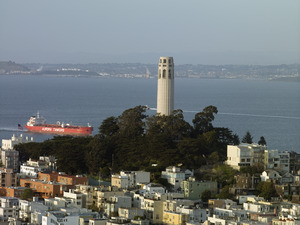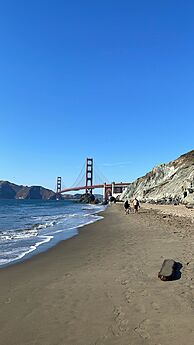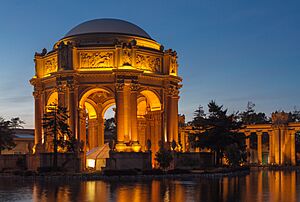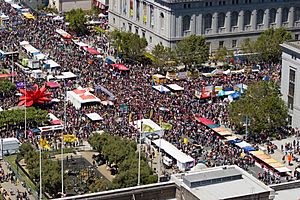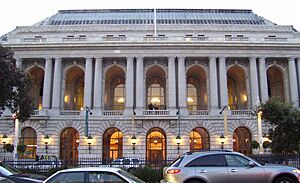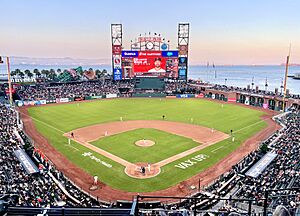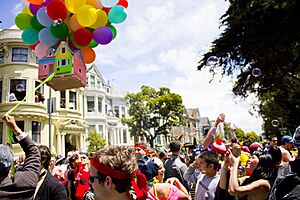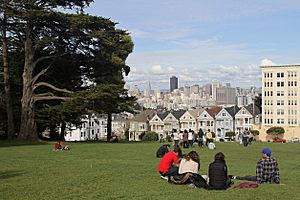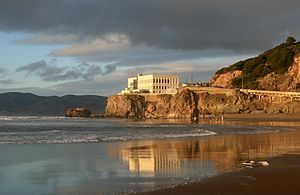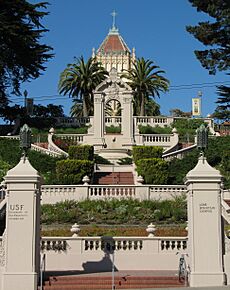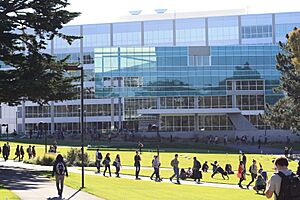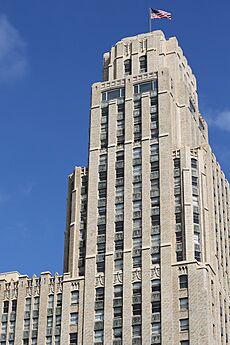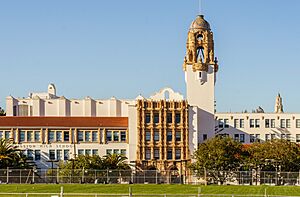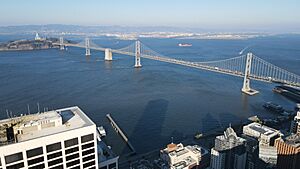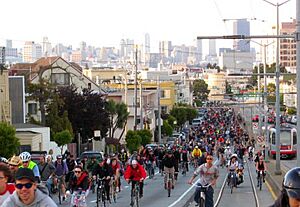San Francisco facts for kids
Quick facts for kids
San Francisco
|
|||
|---|---|---|---|
|
Consolidated city-county
|
|||
| City and County of San Francisco | |||
|
|||
| Nicknames:
See list
|
|||
| Motto(s): | |||
| Anthem: Official song: Theme from San Francisco ("Open your Golden Gate") Official ballad: "I Left My Heart in San Francisco" |
|||
| Country | United States | ||
| State | California | ||
| County | San Francisco | ||
| Metro | San Francisco–Oakland–Hayward | ||
| CSA | San Jose–San Francisco–Oakland | ||
| Mission | June 29, 1776 | ||
| Incorporated | April 15, 1850 | ||
| Founded by | Juan Bautista de Anza José Joaquín Moraga Francisco Palóu |
||
| Named for | St. Francis of Assisi | ||
| Government | |||
| • Type | Mayor-council | ||
| • Body | Board of Supervisors | ||
| Area | |||
| • City and county | 231.89 sq mi (600.59 km2) | ||
| • Land | 46.9 sq mi (121.48 km2) | ||
| • Water | 184.99 sq mi (479.11 km2) 80.00% | ||
| • Metro | 3,524.4 sq mi (9,128 km2) | ||
| Elevation | 52 ft (16 m) | ||
| Highest elevation | 934 ft (285 m) | ||
| Lowest elevation
(Pacific Ocean)
|
0 ft (0 m) | ||
| Population
(2020)
|
|||
| • City and county | 873,965 | ||
| • Estimate
(2023)
|
808,988 | ||
| • Rank | 39th in North America 17th in the United States 4th in California |
||
| • Density | 18,634.65/sq mi (7,194.88/km2) | ||
| • Urban | 3,515,933 (US: 14th) | ||
| • Urban density | 6,843.0/sq mi (2,642.1/km2) | ||
| • Metro | 4,566,961 (US: 13th) | ||
| • CSA | 9,225,160 (US: 5th) | ||
| Demonym(s) | San Franciscan | ||
| Languages | |||
| • Official | English, Spanish, Chinese, Filipino, Vietnamese | ||
| • Other non-official spoken languages | Russian, Persian, Portuguese, and others | ||
| GDP | |||
| • City and county | 3.1 billion (2023) | ||
| • Metro | 8.9 billion (2023) | ||
| • CSA | .397 trillion (2023) | ||
| Time zone | UTC−08:00 (PST) | ||
| • Summer (DST) | UTC−07:00 (PDT) | ||
| ZIP Codes |
List
94102–94105
94107–94112 94114–94134 94137 94139–94147 94151 94158–94161 94163–94164 94172 94177 94188 |
||
| Area codes | 415/628 | ||
| FIPS code | 06-67000 | ||
| GNIS feature IDs | 277593, 2411786 | ||
San Francisco, also known as the City and County of San Francisco, is a major city in Northern California. It's a busy place for business, money, and culture. As of 2023, about 808,988 people live there. This makes San Francisco the fourth-largest city in California, after Los Angeles, San Diego, and San Jose. It's also the 17th most populated city in the whole United States.
San Francisco covers a land area of about 46.9 square miles (121.48 square kilometers). It sits at the top of the San Francisco Peninsula. This makes it the second most crowded major city in the U.S., right after New York City. It's also the fifth most crowded county in the U.S.
Before Europeans arrived, the Yelamu people lived here. They spoke a language called Ramaytush Ohlone. In 1776, Spanish settlers built a fort called the Presidio of San Francisco. They also built a mission, Mission San Francisco de Asís, named after Francis of Assisi.
A big change happened in 1849 with the California gold rush. This made the small village grow into a busy port city. It became the largest city on the West Coast at that time. From 1870 to 1900, about a quarter of California's people lived in San Francisco. In 1856, San Francisco became both a city and a county.
In 1906, a huge earthquake and fire destroyed most of the city. But San Francisco was rebuilt very quickly. Nine years later, it hosted a big event called the Panama–Pacific International Exposition. During World War II, it was an important port for ships heading to the Pacific. In 1945, the United Nations Charter was signed here, creating the United Nations.
San Francisco and the nearby San Francisco Bay Area are important for business, arts, and science. This is thanks to top universities, high-tech companies, healthcare, and finance. The area is known for its steep hills and unique buildings. It also has famous places like Chinatown and the Mission District. The city is famous for its cool summers, fog, and landmarks like the Golden Gate Bridge, cable cars, and Alcatraz.
Many schools and cultural places are in San Francisco. These include the University of California, San Francisco and the San Francisco Museum of Modern Art. Two major sports teams, the San Francisco Giants and the Golden State Warriors, play here. San Francisco International Airport (SFO) connects the city to many places. A network of light rail and buses, along with BART and Caltrain, helps people travel around.
Contents
What's in a Name?
San Francisco means "Saint Francis" in Spanish. The city got its name from the Mission San Francisco de Asís. This mission was named after Saint Francis of Assisi. Spanish settlers founded the mission in 1776.
The city was officially named San Francisco in 1847. Before that, it was called Yerba Buena. This Spanish name means "Good Herb." You can still find the name Yerba Buena in places like Yerba Buena Island.
People outside the Bay Area sometimes call it "Frisco" or "San Fran." But locals often just say "the City" or "SF." Using certain nicknames can sometimes show if someone is a long-time resident or a visitor.
A Look Back at San Francisco's History
Early Native American Life
The first signs of people living in San Francisco go back 3,000 years. The Yelamu people, part of the Ramaytush group, lived in small villages. Spanish explorers first arrived on November 2, 1769. The Ohlone name for San Francisco was Ahwaste, meaning "place at the bay."
Spanish Arrival and Missions
Spain claimed San Francisco as part of its lands. Spanish explorers first came to the area in 1769. They saw the great natural harbor and decided it was a good place for a settlement.
In 1776, Juan Bautista de Anza set up the Presidio of San Francisco, a military fort. Later that year, Padre Francisco Palóu founded Mission San Francisco de Asís. This mission is also known as Mission Dolores.
Mexican Rule and Growth
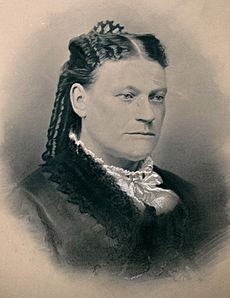
In 1821, Mexico gained independence from Spain. The Spanish missions in California slowly lost their power. Farmland became private ranches. Trade along the coast grew.
The trading post of Yerba Buena grew between the Presidio and the Mission. Its main square was later named Portsmouth Square. In 1833, Juana Briones de Miranda built the first civilian home in San Francisco.
Yerba Buena started to attract settlers from America and Europe. In 1846, American forces took control of Yerba Buena. This happened during the Conquest of California. In 1848, California became part of the United States.
The Gold Rush and City Building

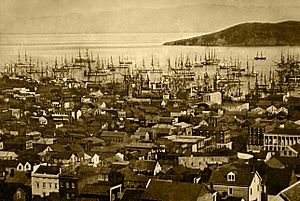
The California gold rush in 1849 brought many people looking for gold. San Francisco's population exploded from 1,000 in 1848 to 25,000 by late 1849. Many sailors left their ships to join the gold rush. Their abandoned ships filled the harbor. Some were used as stores or hotels.
California became a state in 1850. The U.S. military built forts at the Golden Gate and on Alcatraz Island. In 1856, San Francisco became a combined city and county.
The discovery of silver in Nevada in 1859 also helped San Francisco grow. The city became a center for trade. Companies like Levi Strauss (jeans) and Domingo Ghirardelli (chocolate) started here. Chinese immigrants also came, creating the city's Chinatown.
The first cable cars started running in 1873. By 1890, San Francisco had almost 300,000 people. It was the eighth-largest city in the U.S.
The 1906 Earthquake and Rebuilding
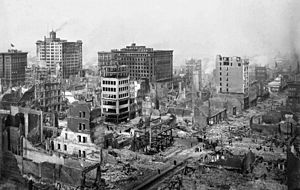
On April 18, 1906, a huge earthquake hit San Francisco. Buildings fell, and broken gas lines caused fires that burned for days. Most of the city was destroyed. Thousands of people died, and over half the population lost their homes. Many people moved away.
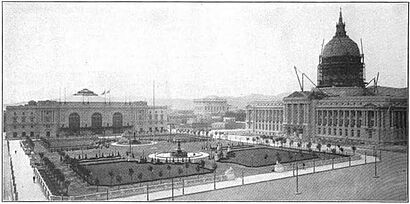
The city was rebuilt very quickly. People chose speed over completely changing the street layout. The Bank of Italy, later Bank of America, helped by giving loans. In 1915, the city celebrated its rebirth with the Panama–Pacific International Exposition.

During this time, important structures were built. These included the Twin Peaks Tunnel and the San Francisco Municipal Railway. The Hetch Hetchy Aqueduct brought plenty of water, helping San Francisco grow.
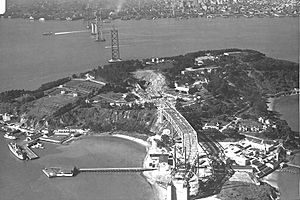
Even during the Great Depression, San Francisco built two huge bridges: the San Francisco–Oakland Bay Bridge (1936) and the Golden Gate Bridge (1937). Alcatraz Island became a famous federal prison.
Modern Times in San Francisco

During World War II, San Francisco was a key port for the military. Many people moved here for jobs. After the war, many stayed. In 1945, the United Nations Charter was signed in San Francisco.
In the 1950s and 60s, new freeways were planned. But citizens protested, and many were stopped. The city's small piers became outdated. Cargo business moved to Port of Oakland. San Francisco lost factory jobs and focused more on tourism. Many white residents moved to the suburbs. More immigrants from Asia and Latin America moved in.

San Francisco became a center for the counterculture movement. Writers and artists of the Beat Generation gathered in North Beach. The Summer of Love in 1967 brought thousands of young people to the Haight-Ashbury neighborhood.

The Transamerica Pyramid was built in 1972. This started a period of building many tall skyscrapers downtown. However, homelessness became a big problem in the 1980s and still is today.
The 1989 Loma Prieta earthquake caused damage. After this, parts of damaged freeways were torn down. This helped bring back the historic waterfront area.
In the late 1990s, the internet boom brought many new companies and people to San Francisco. This changed some neighborhoods, making them more expensive. Even though some tech companies have left downtown recently, technology and new businesses are still very important to the city.
San Francisco's Geography
San Francisco is on the West Coast of the United States. It's at the northern end of the San Francisco Peninsula. The city includes parts of the Pacific Ocean and San Francisco Bay. Several islands are part of the city, like Alcatraz and Treasure Island. The city's mainland is often called a "seven-by-seven-mile square."
There are over 50 hills in the city. Some neighborhoods are named after their hills, such as Nob Hill and Russian Hill. Twin Peaks offers great views. The tallest hill is Mount Davidson, which is 928 feet (283 meters) high.

The San Andreas Fault and Hayward Fault cause many earthquakes nearby. San Francisco has built strong buildings and an extra water system to prepare for quakes.
Much of San Francisco's shoreline is built on landfill. Neighborhoods like the Marina and Mission Bay are on reclaimed land. This land can be unstable during earthquakes.
Exploring San Francisco's Neighborhoods
The historic heart of San Francisco is in the northeast. This area includes the Financial District and Union Square, a main shopping area. Cable cars take people up steep hills to Nob Hill. From there, you can go down to Fisherman's Wharf and Pier 39. These are popular spots with restaurants and views of the bay.
Other neighborhoods in this area are Russian Hill, known for its famously crooked Lombard Street. North Beach is the city's "Little Italy." San Francisco's Chinatown is the oldest in North America. The South of Market area, once industrial, now has new skyscrapers and homes.
West of downtown is the Western Addition. This area includes Hayes Valley and Japantown. Many of its Victorian homes survived the 1906 earthquake, like the famous "Painted Ladies" near Alamo Square. To the south is Haight-Ashbury, known for its 1960s hippie culture.
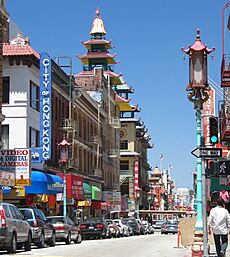
North of the Western Addition is Pacific Heights, a wealthy neighborhood. The Marina is popular with young people.
In the southeast is the Mission District. It was settled by immigrants from Germany, Ireland, and later Central America and Mexico. Now, it's seeing changes with new residents. The Castro is known as North America's first gay village.
The Sunset District and Richmond District are large middle-class areas. They stretch west to the Pacific Ocean. Many Asian immigrants live here.
The Ferry Building on the Embarcadero has been restored. It's now a gourmet marketplace and still serves commuter ferries.
San Francisco's Climate
San Francisco has a mild climate all year. Cool ocean currents and the bay water keep temperatures steady. Summers are dry, and winters are moist.
In summer, hot air from California's valleys pulls cool winds and fog through the Golden Gate. This fog is less common in eastern neighborhoods. Because of the fog, September is usually the warmest month.
Temperatures rarely go above 80°F (27°C). The dry season is from May to October. The rainy season is from November to April. Snow is very rare in the city. The highest temperature ever recorded was 106°F (41°C) in 2017. The lowest was 27°F (-3°C) in 1932.
People and Culture
| Historical population | ||
|---|---|---|
| Year | Pop. | ±% |
| 1848 | 1,000 | — |
| 1849 | 25,000 | +2400.0% |
| 1852 | 34,776 | +39.1% |
| 1860 | 56,802 | +63.3% |
| 1870 | 149,473 | +163.1% |
| 1880 | 233,959 | +56.5% |
| 1890 | 298,997 | +27.8% |
| 1900 | 342,782 | +14.6% |
| 1910 | 416,912 | +21.6% |
| 1920 | 506,676 | +21.5% |
| 1930 | 634,394 | +25.2% |
| 1940 | 634,536 | +0.0% |
| 1950 | 775,357 | +22.2% |
| 1960 | 740,316 | −4.5% |
| 1970 | 715,674 | −3.3% |
| 1980 | 678,974 | −5.1% |
| 1990 | 723,959 | +6.6% |
| 2000 | 776,733 | +7.3% |
| 2010 | 805,235 | +3.7% |
| 2020 | 873,965 | +8.5% |
| 2023 | 808,988 | −7.4% |
| https://www.sfchronicle.com/sf/article/s-f-exodus-population-recovery-data-18564064.php | ||
In 2020, San Francisco's population was 873,965. It's one of the most crowded big cities in America. San Francisco is part of a larger metropolitan area with 4.7 million people. The even larger San Jose–San Francisco–Oakland area has over 9.6 million people.
Diverse Communities and Languages
San Francisco is a very diverse city. In 2020, about 41.3% of residents were White. About 33.9% were Asian, and 15.6% were Hispanic or Latino. African Americans made up about 5.3% of the population.
Chinese people are the largest Asian group, making up 21% of the city. Filipinos and Vietnamese are also large groups. The Tenderloin District has a large Vietnamese community.
Hispanic groups include Mexicans and Salvadorans. They mostly live in the Mission District, Tenderloin, and Excelsior District. African Americans mostly live in Bayview-Hunters Point and the Fillmore District.
San Francisco also has a large Jewish community. In 2018, they made up about 10% of the city's population.
In 2010, 55% of San Francisco residents spoke only English at home. Many others spoke Chinese, Spanish, or Tagalog. In total, 45% of people spoke a language other than English at home.
Education and Living in San Francisco
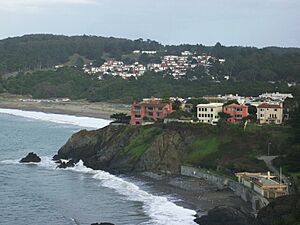
San Francisco has one of the highest percentages of college graduates in the U.S. Over 44% of adults have a bachelor's degree or higher.
The city has a higher percentage of same-sex households than any other U.S. county. San Francisco also ranks high in median household income. However, the city has a lower number of children compared to other large American cities.
Homelessness has been a long-term problem in San Francisco since the 1970s. The city spends a lot of money to help people experiencing homelessness. In 2018, a UN expert said the conditions for homeless people in San Francisco were "deplorable."
San Francisco's Economy
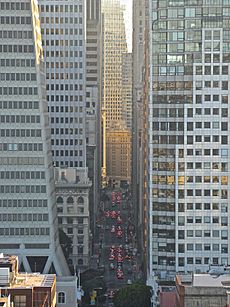
San Francisco has a diverse economy. Many people work in professional services, including tourism, financial services, and high tech. In 2016, about 27% of workers were in business services.
The city's history with the California gold rush made it a banking and finance center. Montgomery Street in the Financial District is known as the "Wall Street of the West." Many large banks and investment firms are based here. San Francisco is considered an "Alpha(-) World City" because of its global importance in finance.
Since the 1990s, San Francisco's economy has grown in high tech, biotechnology, and medical research. It became a hub for internet start-up companies during the dot-com bubble. Many tech companies have offices here.
The city government is the largest employer in San Francisco. UCSF is the second largest. The largest private employer is Salesforce. Small businesses are very important to the city's economy. San Francisco tries to support local businesses and limit large chain stores.

Manufacturing used to be big in San Francisco, but most factories moved away. However, there has been a small return of manufacturing jobs recently.
San Francisco has some of the highest home values in the U.S. In 2022, the average home value was over $1.2 million.
Technology and Innovation
San Francisco became a center for technology during the internet boom of the 1990s. It's still a key city in the world of technology. Many tech companies like Apple, Google, and Twitter have offices here.
Recently, many AI companies have started or moved to San Francisco. This is because of the large number of talented people and access to funding.
Tourism and Visitors
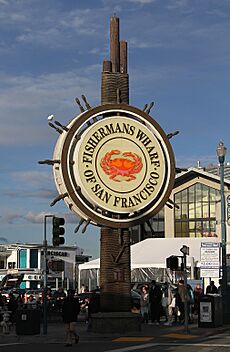
Tourism is one of San Francisco's most important industries. It creates many jobs in the city. San Francisco is famous worldwide from movies and songs. In 2016, over 25 million visitors came to the city.
San Francisco is a popular place for conventions and conferences. The Moscone Center is a major convention facility.
Popular tourist attractions include the Golden Gate Bridge and the "Painted Ladies" houses at Alamo Square. These were seen in the TV show Full House. Lombard Street is famous for its "crookedness." Tourists also visit Pier 39 for dining, shopping, and seeing California sea lions. Alcatraz Island is another famous spot.
San Francisco also has a lively nightlife in its neighborhoods. The new Pier 27 cruise terminal opened in 2014. Cruises from San Francisco often go to Alaska and Mexico.
Arts and Culture
San Francisco is known for its many neighborhoods with mixed businesses and homes. People can easily walk to shops, restaurants, and venues. This makes San Francisco one of the "most walkable" cities in the U.S.
Since the 1990s, many skilled tech workers have moved to San Francisco. This has made the cost of living very high. Many neighborhoods that used to be for working-class families have become more expensive. Property values and incomes are among the highest in the nation.

San Francisco has always been a city of immigrants. Many people from Asia and Latin America live here. The annual Chinese New Year Parade is the largest of its kind on the West Coast.
The city became a center for liberal ideas and the counterculture in the 1950s and 60s. The Democrats are very strong in city politics. San Francisco has also been a leader in environmental efforts. It had one of the first curbside recycling programs.
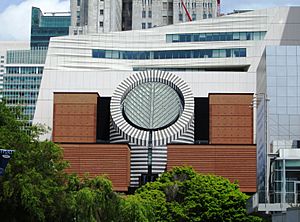
LGBT Community and Pride
San Francisco has a long history of being welcoming to the LGBT community. It was home to the first lesbian-rights organization in the U.S. and the first openly gay person elected to public office in California, Harvey Milk.
The city has a large gay population. This community has been very active in San Francisco's civic life. San Francisco hosts San Francisco Pride, one of the largest and oldest LGBT pride events in the world. Over 1.5 million people attended in 2013.
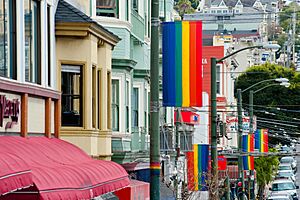
Performing Arts Scene

San Francisco has many famous performing arts groups. The War Memorial Opera House is home to the San Francisco Opera and the San Francisco Ballet. The San Francisco Symphony performs at Davies Symphony Hall. The SFJAZZ Center hosts jazz shows.
The Fillmore is a famous music venue. Many well-known musicians like the Grateful Dead and Janis Joplin performed there in the 1960s. San Francisco also has many theaters. The American Conservatory Theater (A.C.T.) is a Tony Award-winning company.
Museums to Explore
The San Francisco Museum of Modern Art (SFMOMA) displays modern and contemporary art. It reopened in 2016 after a big expansion. The California Palace of the Legion of Honor has European art. The de Young Museum in Golden Gate Park features American and international art. The Asian Art Museum focuses on Asian art.
Next to the de Young Museum is the California Academy of Sciences. This natural history museum has a planetarium and an aquarium. The Exploratorium on Pier 15 is an interactive science museum. The Cable Car Museum shows how the city's cable cars work.
Sports in San Francisco
The Major League Baseball team, the San Francisco Giants, moved here in 1958. They play at Oracle Park. The Giants won the World Series in 2010, 2012, and 2014. Famous players like Willie Mays and Barry Bonds have played for the Giants.
The San Francisco 49ers are an NFL team. They started playing in 1946. In 2014, the team moved its home games to Santa Clara. But the 49ers are still known as a San Francisco team. They have won five Super Bowl titles.
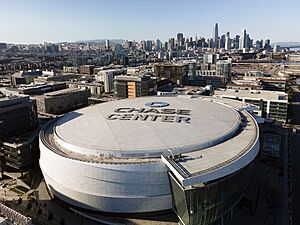
The NBA team, the Golden State Warriors, moved to the Bay Area in 1962. Their arena, Chase Center, is in San Francisco. They have won five championships since moving to the Bay Area. They won a championship in 2022 while in San Francisco.
At the college level, the San Francisco Dons play in NCAA Division I. Bill Russell led the Dons basketball team to national championships in 1955 and 1956.
The Bay to Breakers footrace is held every year since 1912. It's known for its colorful costumes and party atmosphere. The San Francisco Marathon attracts over 21,000 runners. The Escape from Alcatraz triathlon is a challenging race.
San Francisco is great for outdoor activities. There are over 200 miles (320 km) of bike paths. Many residents are very fit. Golden Gate Park has running trails, a golf course, and a disc golf course.
Parks and Outdoor Fun

Many of San Francisco's parks and beaches are part of the Golden Gate National Recreation Area (GGNRA). This is one of the most visited national park areas in the U.S. It includes Ocean Beach, popular for surfing, and Baker Beach. The GGNRA also manages the Presidio of San Francisco, Fort Funston, and Alcatraz.
The San Francisco Recreation & Parks Department maintains over 220 parks. The biggest and most famous is Golden Gate Park. It stretches from the city center to the Pacific Ocean. The park has gardens, museums, and other attractions.
Lake Merced is a freshwater lake surrounded by parkland. Near it is the San Francisco Zoo. Most of San Francisco's islands are protected as parks or wildlife areas. Alcatraz Island is open to the public.
San Francisco is the first U.S. city to have a park within a 10-minute walk of every resident. It ranks high for park access and quality.
Education in San Francisco
Colleges and Universities
The University of California, San Francisco (UCSF) focuses on health and medical sciences. It's one of the top medical schools in the U.S. UCSF is a major employer in the city.
The University of California College of the Law, San Francisco, founded in 1878, is the oldest law school in California. San Francisco State University is part of the California State University system. It has about 30,000 students.
City College of San Francisco is one of the largest two-year colleges in the country. It has about 100,000 students.
The University of San Francisco, founded in 1855, is the oldest higher education school in San Francisco. The Academy of Art University is the largest art and design school in the nation. The San Francisco Conservatory of Music is the only independent music school on the West Coast.
Schools for Kids
Public schools are managed by the San Francisco Unified School District. This district covers the entire city and county. Lowell High School is the oldest public high school west of the Mississippi River.
About 30% of school-age children attend private or religious schools. Nearly 40 of these are Catholic schools. San Francisco offers universal access to preschool for all four-year-old children.
Media and News

The main daily newspaper is the San Francisco Chronicle. It's the most widely read newspaper in Northern California. The San Francisco Examiner is now a free daily newspaper.
Sing Tao Daily is one of several Chinese language newspapers. SF Weekly is the city's alternative newspaper. San Francisco and 7x7 are popular magazines about the city.
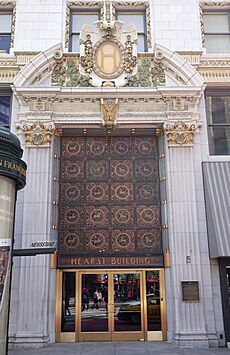
The San Francisco Bay Area is a large television and radio market. All major U.S. television networks have local stations here. News channels like CNN and BBC also have offices in San Francisco.
Public broadcasting stations include KQED-TV and KQED-FM radio. KQED-FM is the most-listened-to National Public Radio station in the country.

Sutro Tower is a tall broadcast tower located between Mount Sutro and the Twin Peaks. It was built in 1973.
Getting Around San Francisco
Public Transportation
Public transportation is very popular in San Francisco. Over 560,000 people use Muni's bus routes every weekday. The San Francisco Municipal Railway, known as Muni, is the main public transit system. It runs a light rail and subway system called the Muni Metro. It also has a large network of buses and trolley coaches.
Muni operates a historic streetcar line and the famous cable cars. The cable cars are a National Historic Landmark and a big tourist attraction.
Bay Area Rapid Transit (BART) connects San Francisco to the East Bay and San Jose. It runs under Market Street and then south through the city. BART also connects to San Francisco International Airport.

Another train system, Caltrain, runs from San Francisco down the San Francisco Peninsula to San Jose.
San Francisco Bay Ferry and Golden Gate Ferry operate ferries from the Ferry Building. They connect the city to places in the East Bay and North Bay.
Roads and Bridges
In 2014, only about 41% of residents drove to work alone or carpooled. San Francisco has over 1,000 miles (1,600 km) of streets. Due to protests in the 1950s, San Francisco has fewer freeways than many other big cities.
Interstate 80 starts at the Bay Bridge. It's the only direct road link to the East Bay. U.S. Route 101 connects to the Bay Bridge approach and goes south towards Silicon Valley. Northward, U.S. 101 uses city streets to reach the Golden Gate Bridge. This bridge is the only direct road link to Marin County.
After the 1989 Loma Prieta earthquake, parts of damaged freeways were torn down. This helped improve areas like the Embarcadero.
Vision Zero Safety Plan
In 2014, San Francisco started "Vision Zero." The goal is to end all traffic deaths caused by vehicles in the city by 2024. The plan focuses on improving roads, enforcing rules, and educating people.
Airports

San Francisco International Airport (SFO) is about 13 miles (21 km) south of downtown. It's managed by the City and County of San Francisco. SFO is a major airport for flights to Asia and Europe. In 2011, it was the eighth-busiest airport in the U.S.
The San Jose International Airport (SJC) and Oakland International Airport are other airports in the Bay Area.
Biking and Walking
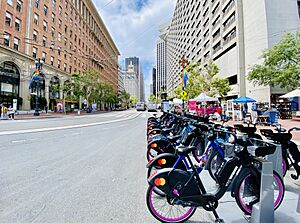
Biking is a popular way to get around San Francisco. About 75,000 residents bike to work every day. The city has added more cycling infrastructure like bike lanes. Bay Wheels is a bike-sharing program that started in 2013.
Walking is also very common. In 2015, San Francisco was ranked the second-most walkable city in the U.S.
However, San Francisco has higher rates of pedestrian and bicyclist deaths from traffic accidents than the U.S. average. The city is working to improve safety for walkers and bikers.
Sister Cities
San Francisco has "sister city" relationships with other cities around the world. These partnerships help promote cultural ties. In 1980, San Francisco became a sister city with Shanghai, China.
Notable People
See also
 In Spanish: San Francisco (California) para niños
In Spanish: San Francisco (California) para niños


